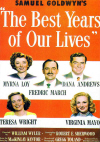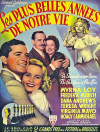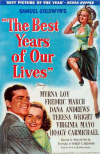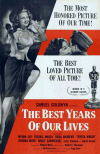
 It was appropriate and heartening that the first important post-war
Hollywood film was a mature, engrossing drama about the return of
servicemen to civilian life, a familiar cross-section estimation of
the ways in which representatives of three significant types phase
out of their war-conditioned thinking and back to standard peacetime
frames of mind. The film was
William Wyler's perceptive The
Best Years of Our Lives, from a screenplay by Robert E. Sherwood,
which Samuel Goldwyn produced. At the time it was released in
November 1946, this impulsively sympathetic picture of
servicemen home from the war was fully and accurately reflective of
the sentiments and ethos of the times—so much so that it was warmly
hailed by critics of all persuasions as the best picture of the year
and was quickly inflated by the public into a big box-office hit.
It was appropriate and heartening that the first important post-war
Hollywood film was a mature, engrossing drama about the return of
servicemen to civilian life, a familiar cross-section estimation of
the ways in which representatives of three significant types phase
out of their war-conditioned thinking and back to standard peacetime
frames of mind. The film was
William Wyler's perceptive The
Best Years of Our Lives, from a screenplay by Robert E. Sherwood,
which Samuel Goldwyn produced. At the time it was released in
November 1946, this impulsively sympathetic picture of
servicemen home from the war was fully and accurately reflective of
the sentiments and ethos of the times—so much so that it was warmly
hailed by critics of all persuasions as the best picture of the year
and was quickly inflated by the public into a big box-office hit.
It tells of three men of different ages,
social backgrounds and military roles who return to the same home
town together and, in their various ways, face the difficulties of
readjustment that their separate circumstances impose. The
eldest is a graying Army sergeant who had been a successful banker
before the war and is returning to a wife, two full-grown children
and a comfortable banking job, but whose capitalistic concepts have
been jolted by his leveling experiences. Next is an Air Force
captain, a much-decorated bombardier, who had been a mere drugstore
soda jerk before going away to war; he is returning to a virtually
unknown bride he had married just before he was shipped abroad and
to the realization that he has no education for anything but jerking
sodas and dropping bombs. And the youngest is a former
high-school student who serves as a Navy machinist's mate and has
lost both hands in an explosion; they were replaced with mechanical
hands, or "hooks."
Wyler, who had been a colonel in the Air
Force and had been chief of the unit that made the excellent Eighth
Air Force documentary, The Memphis Belle,
had seen an Army-made film called Diary of a Sergeant, which gave a stringently factual picture
of how a paratroop sergeant who had lost both hands in a dynamite
explosion had been outfitted with such "hooks" and trained to use
them so that he could perform most of the manual functions of a
normal person. Then he discovered that the amputee was a young
man named Harold Russell who, though not a professional actor, was
so right in appearance for the role and so eager to take it that he
persuaded Sherwood and Goldwyn to let him sign Russell.

 The move was providential, for a major
climactic scene is one in which the troubled sailor demonstrates in
literal detail to his girl, the high-school sweetheart whose
reaction to his injury he most profoundly dreads, how he has to get
out of his harness every night when he goes to bed and thus be
rendered helpless and perhaps physically repulsive to her.
This scene, with its accumulated tension of uncertainty between the
boy and the girl and its simply stated realization of their mutual
discomfort, was one of the most affecting and compelling at the time
the film was released. It gained an undoubted accretion of
emotional impact and sympathy from audience awareness that Russell
was a veteran and a genuine amputee. Thus did Wyler sustain,
even briefly, his feeling, acquired while making The Memphis
Belle, that some of the most convincing screen behavior could be
got from people not trained to perform.
The move was providential, for a major
climactic scene is one in which the troubled sailor demonstrates in
literal detail to his girl, the high-school sweetheart whose
reaction to his injury he most profoundly dreads, how he has to get
out of his harness every night when he goes to bed and thus be
rendered helpless and perhaps physically repulsive to her.
This scene, with its accumulated tension of uncertainty between the
boy and the girl and its simply stated realization of their mutual
discomfort, was one of the most affecting and compelling at the time
the film was released. It gained an undoubted accretion of
emotional impact and sympathy from audience awareness that Russell
was a veteran and a genuine amputee. Thus did Wyler sustain,
even briefly, his feeling, acquired while making The Memphis
Belle, that some of the most convincing screen behavior could be
got from people not trained to perform.
The Best Years of Our Lives is essentially a drama of the isolation and reserve of the
returning veteran. It recollects and clarifies how he resists
casting off his attachment to the service and the security it gave,
and a bit about how the homefolk either help or resist him.
The psychological dilemma is superbly
stated in the opening scene of the three men hitching a ride back to
their home town in a retiring Air Force bomber. Here they are,
clustered together in the Plexiglas nose of the plane, nervous and
excited, still very much servicemen feeling themselves apart and
alienated from the people at home. They are intensely and
volubly conscious of their separateness and inwardly scared of their
own individual capacities to face up to "rehabilitation."
Though they talk a bit too glibly and boastfully of their desires to
get out of their uniforms and again be normal, inconspicuous
civilians, they fear the transition. Everything they do and
say betrays their impulse to hang onto their distinctions, to the
codes and esprit of the military caste, and signifies their
skepticism toward the civilian frame of mind.
In this excellent scene in the bomber,
we are quickly introduced to our men: Al, the most articulate,
a sharp and sardonic older guy, played with appropriate ostentation
and just the right shade of insecurity by Fredric March; Fred, the
bombardier, whom Dana Andrews endows with a flat, formless voice and
an air of reserve that barely cover his bristling watchfulness and
instability; and Homer, played by Russell with an appealingly boyish
clumsiness that makes all the more impressive the dexterity he
displays with his "hooks."
It is remarkable how shrewdly Wyler and
Sherwood have constructed the film to keep impressing by visual data
the lonely isolation of these men-by showing their detachment and
aloofness as they peer from the nose of the plane as it approaches
their town, spotting landmarks, noting people playing golf on the
local course "as though nothing had happened," sighting an
unfamiliar "graveyard" for junked planes; and then by recording
their amazement as they ride through town in a taxicab, catching
significant changes: a used-car lot, a bunch of reckless kids
riding in jalopies, a new neon sign on Butch's place, the bar run by
Homer's uncle which is to be their later place of rendezvous.

_NRFPT_02_small.jpg) Indicative of the obstructions each man
has to surmount are the discomfort and embarrassment each feels
within a few hours after getting home. Homer can't endure
sitting sweetly and talking with his parents and his expected
father-in-law, who is blunt and insensitive in referring to his
handicap and his limited prospects for a job. Al is confused
by his wife and daughter and miffed that his high-school son is
politely but firmly uninterested in the war souvenirs he has brought
home. Fred has been unable to locate his wife. Soon they
have all gravitated to the masculine sanctuary of Butch's bar,
seeking that place designated as a familiar haven for lonely
servicemen—even though Al, in his confusion, does bring his wife and
daughter along.
Indicative of the obstructions each man
has to surmount are the discomfort and embarrassment each feels
within a few hours after getting home. Homer can't endure
sitting sweetly and talking with his parents and his expected
father-in-law, who is blunt and insensitive in referring to his
handicap and his limited prospects for a job. Al is confused
by his wife and daughter and miffed that his high-school son is
politely but firmly uninterested in the war souvenirs he has brought
home. Fred has been unable to locate his wife. Soon they
have all gravitated to the masculine sanctuary of Butch's bar,
seeking that place designated as a familiar haven for lonely
servicemen—even though Al, in his confusion, does bring his wife and
daughter along.
It is interesting and provocative that
Al is the heaviest drinker of the lot, that he starts within a few
minutes after he gets home and is sloppily drunk by the time they
reach Butch's bar. One begins to wonder about his relation to
his wife and his environment before he left - whether possibly he
went into the service because he was restless, bored; whether maybe
he enjoyed his greatest sense of "belonging" in the service, and
that's why he is loath to give it up.
The constant refrain is the reluctance
of the serviceman to take up where he left off, to resume his
previous status and function in his environment. Invariably he
feels that his experience has changed his outlook and privileges.
Homer has lost motivation. He isn't interested in looking for
a job. He feels that his disability entitles him to live on a
pension of $100 a month. Al resists the urging of the bank
president to return to his old job. Scornfully, he mocks the
cruel compulsion: "Last year it was 'kill Japs,' this year
it's 'make money.' " And when he does settle back into harness in
charge of the small loans department at
the bank, his crucial gesture of defiance is to give a small loan,
without collateral, to a sturdy young former Seabee who wants to buy
a farm.
Fred's resistance is tougher, more complex and justified. He
doesn't want to go back to being a soda jerk in the now
chain-controlled drugstore and jimcrack novelty emporium where he
used to work. He feels that his experience and his service as
a warrior qualify him for more. But he does go back, on the
pretext of being an assistant manager filling in at the old job,
until he finally takes a poke at a customer who talks scornfully
about the worthiness of the war.
Worse for him, however, is the fact that his "war bride" wife has
little respect for him and, indeed, finds him unromantic out of
uniform. She cheats on him with another fellow and eventually
demands a divorce.
But his hardest and most discouraging letdown is when his supposed
friend Al, now returned to normal, puts him in his place by ordering
him to stay away from his daughter, whom Fred has been seeing
fitfully since that first night home, when she soothed him and
showed him sympathy. One of the strongest scenes in the
picture is one in Butch's bar, when Al, suddenly very bourgeois,
brutally puts it on the line: "I want my daughter to marry a
decent guy." And then, in a stunning composition, we see Fred
in a telephone booth at the end of the room, calling the daughter to
tell her he will not see her again, while Al stands in the
foreground by the piano, watching Homer, accompanied by his uncle,
play "Chopsticks" with his "hooks." All the irony of the
dissolution of the service man's esprit is in this one shot.
_NRFPT_01_small.jpg)
_NRFPT_01_small.jpg) Then the nadir of Fred's self-pity and desolation is conveyed in a
memorable scene in which he wanders, on the verge of leaving town,
through the "graveyard" of old junked bombers, standing stripped and
forlorn, waiting for the junkman's sledgehammer, symbols of a glory
that is gone. He climbs into the nose of a dead B-17 bomber
and all the anguish of his lot comes over him. That is to say,
it comes over the viewer, who is feeling with him. It is a
poetic evocation of valorous and proud memories, and it sums up the
evanescence of the wartime repute of the serviceman.
Then the nadir of Fred's self-pity and desolation is conveyed in a
memorable scene in which he wanders, on the verge of leaving town,
through the "graveyard" of old junked bombers, standing stripped and
forlorn, waiting for the junkman's sledgehammer, symbols of a glory
that is gone. He climbs into the nose of a dead B-17 bomber
and all the anguish of his lot comes over him. That is to say,
it comes over the viewer, who is feeling with him. It is a
poetic evocation of valorous and proud memories, and it sums up the
evanescence of the wartime repute of the serviceman.
This is, indeed, the climax and ultimate statement of the film.
Al has accomplished his transition by making that unsecured loan to
an ex-Seabee and then telling his skeptical associates at a
welcome-home dinner that we didn't win battles in the Pacific by
first demanding collateral. That is enough propitiation for
his shallow sense of rectitude. Homer has shown his sweetheart
what it will mean to endure a man with "hooks," and has received her
gentle reassurance. Evidently he has crossed his bridge.
But Fred is the one left hanging. He is the one revealed as
having reached a peak in the service that he will never come up to
again. And we know he won't, despite an effort by Sherwood and
Wyler to force a happy prospect for him by giving him a small job
with the junkman and making it look as though Al's daughter will
"wait for him." We know he's the sort of fellow who truly had
his "best years" in the war. It is too bad the ending of the
picture is not that last shot of him in the junked plane.
Because he has the best role, the most forthright and meaningful,
Dana Andrews is privileged to give the best performance in the film.
His Fred is a poignant reflection of simple virtues and complex
weaknesses, a clear and classic victim of the forces of an ironic
fate. Ironically, his performance was the one that was not
recognized by the Academy Awards.
Fredric March as Al is
excellent as what he was not first recognized to be—a
voluble, superficial, two-faced mediocrity. His basic insincerity
and fraudulence are aptly camouflaged by characteristic clowning and
delivery of glib, colloquial lines.
Wyler aptly used Gregg Toland's camera to get the texture and tone
of the American scene, and some very effective implications are in
Hugo Friedhofer's musical score.
Later films were to look further into
particular problems of ex-servicemen. Edward Dymtryk's
Crossfire (1947) is about a veteran faced with
anti-Semitic prejudice. Stanley Kramer's Home of the Brave
(1949) is about a Negro soldier who becomes psychopathic
because of the manner in which he is abused. But first and
most extensive is The Best Years of Our Lives.
It is a moving, valuable addenda to the cinema's body
of contemplations of the consequences of war.
